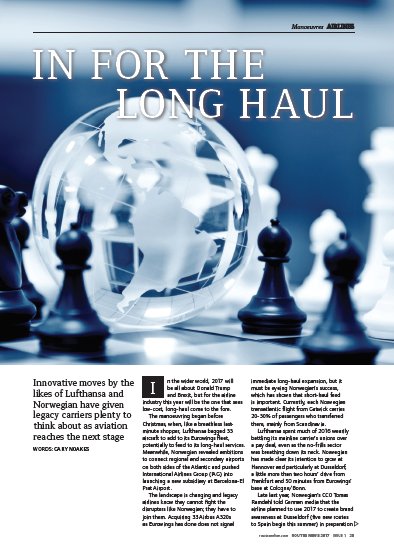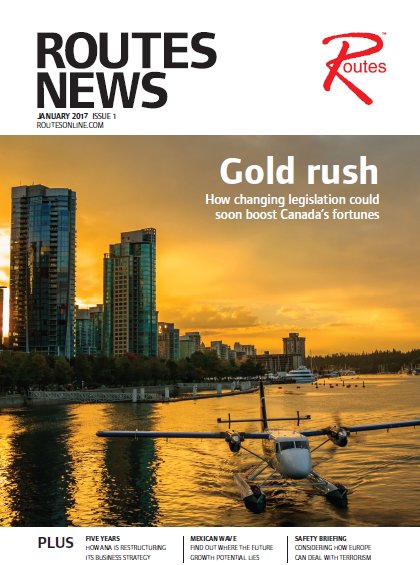
In the wider world, 2017 will be all about Donald Trump and Brexit, but for the airline industry this year will be the one that sees low-cost, long-haul come to the fore. The manoeuvring began before Christmas, when, like a breathless last minute shopper, Lufthansa bagged 33 aircraft to add to its Eurowings fleet, potentially to feed to its long-haul services. Meanwhile, Norwegian revealed ambitions to connect regional and secondary airports on both sides of the Atlantic and pushed International Airlines Group (IAG) into launching a new subsidiary at Barcelona-El Prat Airport.
The landscape is changing and legacy airlines know they cannot fight the disrupters like Norwegian; they have to join them. Acquiring 33 Airbus A320s as Eurowings has done does not signal immediate long-haul expansion, but it must be eyeing Norwegian’s success, which has shown that short-haul feed is important. Currently, each Norwegian transatlantic flight from Gatwick carries 20-30% of passengers who transferred there, mainly from Scandinavia.
Lufthansa spent much of 2016 wearily battling its mainline carrier’s unions over a pay deal, even as the no-frills sector was breathing down its neck. Norwegian has made clear its intention to grow at Hannover and particularly at Dusseldorf, a little more than two hours’ drive from Frankfurt and 50 minutes from Eurowings’ base at Cologne/Bonn.
Late last year, Norwegian’s CCO Tomas Ramdahl told German media that the airline planned to use 2017 to create brand awareness at Dusseldorf (five new routes to Spain begin this summer) in preparation for the launch of long-haul flights next year. These, he said, would initially be to the US, with Asia following, although company sources have since downplayed this, saying nothing will happen “for the next few years”.
Whenever it happens, Norwegian has form here, having raised its profile at Gatwick through short-haul expansion before branching into long haul. In which case, Lufthansa can expect something at some point, as Dusseldorf and Cologne/Bonn are of interest to both carriers, being in one of the largest catchment areas in Europe.
Eurowings was able to bolster its fleet following a deal with downsizing airberlin that will permit 32 new routes from Munich in 2017. Lufthansa Group will use Eurowings to protect its position against foreign no-frills carriers at Munich and, perhaps, to prepare for the launch of a long-haul network. For now, Eurowings’ long-haul ambitions are confined to Cologne/Bonn, where 10 Airbus A330- 200s operate to 14 destinations. Last year, the airport added 1.6 million passengers to reach 11.9 million, due mainly, it says, to Eurowings’ long-haul flights and in July, Seattle, Windhoek, Las Vegas and Orlando will start.
Lufthansa Group is in theory able to transfer more Airbus A330 and A340s – some 50-plus aircraft - over to its subsidiary if Eurowings expands at Cologne and elsewhere, (perhaps beginning with Munich), but is not, of course, confined to Germany.
One clue to its thinking came in January when Lufthansa bought the remaining 55% of Brussels Airlines it did not already own and revealed that the Belgian carrier would retain the Brussels Airlines brand but with the strapline “member of the Eurowings Group”, rather than point to its Lufthansa heritage. At the time, it pledged that: “Brussels Airlines will assume an important role in the further development of the Eurowings Group into a pan-European platform”.
Brussels Airlines has nine A330s and strength in serving former Belgian colonies in Africa, one market where the budgetlong-haul formula might be easily applied. It begins flights to Mumbai in March, another market where price is king.
Lufthansa Group CEO Carsten Spohr told media in Brussels that: “We see a lot more consolidation to come” and said the deal would create “a more pan-European Eurowings” with 180 aircraft. Fresh thinking will become evident when new CEO Thorsten Dirks joins Eurowings in May from Telefonica. His telecommunications sector experience should serve the airline well, with digital streaming being the future of in-flight entertainment and the direct sales platform the preferred medium.
Before he joins, Dirks will doubtless be watching how Norwegian is leading the field. Having used the Boeing 787 Dreamliner to slash fares to the US from Scandinavia and the UK, Norwegian is about to play another trump card in the form of the Boeing 737 MAX. The first 189-seat narrowbody is delivered in June and debuts at Edinburgh, with its first destination an unspecified New York airport.
Boeing will not divulge what runway length the MAX needs, but options apart from Newark (where Norwegian’s Barcelona flights will head) could include Stewart International, 60 miles north of Manhattan, with an 11,800-feet runway, or, if payload allows, MacArthur, 60 miles east, with 7,000 feet, 1,400 feet less than Edinburgh. Either of these latter two would mean low-cost, long-haul at its purest, with cheap airports and the MAX’s economics driving down fares and pushing up margins.
What comes after is still under wraps, but a Norwegian spokesperson added: “We are not looking at Manchester at the moment.” He did confirm, however, that some of the nine 787-9s being delivered in 2017 would be flying from Gatwick to non-US routes.
Norwegian will use the 787 to debut at Barcelona-El Prat Airport in March with flights to New York, Fort Lauderdale, Oakland and Los Angeles. This incursion into IAG territory has prompted a reaction from the group, whose Vueling budget brand is based there. IAG will launch what it calls a “next generation long-haul operation” in June, using feed from Vueling’s 15 million passengers there.
The group is playing catch-up here and at Gatwick, where British Airways (BA) will move onto Norwegian’s Fort Lauderdale and Oakland routes this summer and with BA boss Alex Cruz having admitted Norwegian had taught the airline there were destinations that it “had no idea people wanted to fly to”.
IAG says routes being considered from El Prat “include Los Angeles, San Francisco, Buenos Aires, Santiago de Chile, Havana and Tokyo” using a pair of Airbus A330s. It adds that no decision has been made about whether to set up a new airline or use an existing IAG brand. Iberia in some form seems the obvious choice although Aer Lingus has the lowest long-haul cost base among all IAG brands.
Another player may emerge in 2017 if new Air France/KLM group CEO Jean-Marc Janaillac can persuade unions to cooperate. Janaillac, who insists that “the status quo is no longer possible”, plans to operate 10 aircraft by 2020. Comprising only 10% of the airlines’ long-haul network, it is however a toe in the water and plans to initially operate Airbus A340s, not the most economical of aircraft.
Low-cost long-haul will be driven further by two new aircraft types, providing passengers can be persuaded that narrow bodies are an acceptable way to fly long distances. The evidence is that they can, as even before carriers like Wow Air proved that price is the driver, legacy carriers had been using the Boeing 757 on thinner transatlantic routes for decades.
Norwegian is likely to put the Boeing 737 MAX into service first and Edinburgh-New York will be a coup. The MAX 8 variant Norwegian will use has a range of 3,515 Nautical Miles, covering the 2,830NM sector with ease. Westjet and Ryanair also have the MAX on order, but Norwegian will trump Ryanair’s transatlantic ambitions with it.
Things move on a stage further in 2019 when Airbus introduces its A321LR, boasting a range of 4,000NM and carrying around 220 passengers; making it the longest-range single aisle aircraft and meaning that the US eastern seaboard can be reached from most of Europe.
The aircraft is mooted as the nearest thing to a 757 replacement and can also reach Asia from northern Europe, South East Asia from Australia and most of South America from Florida. Norwegian has 30 on order, and Azores Airlines will use it to expand transatlantic routes. New York’s JetBlue agreed to buy 30 in July, with the airline stating that it “will give us transatlantic range”. The carrier has already shaken up transcontinental routes with its Mint premium cabin and will outline its transatlantic intentions by the end of this year.
If anyone tries to tell you that all this is new, point out that really, it isn’t. Over in Australia and Asia, they may be watching with some amusement as Europe’s legacy carriers adjust to the new reality. Qantas will smugly point out that it launched its first long-haul Jetstar flight, to Honolulu, in late 2006, with Singapore Airlines following with its offshoot Scoot in 2012. Both have proved that the two-brand strategy works, even with some route duplication.
Lufthansa, IAG and others are learning this lesson. It might be a little late, but 2017 looks to be the year when the some subtle and not so subtle manoeuvring begins and the travelling public and some delighted secondary airport owners start to reap the benefits. The revolution is under way.
 |
This article is modified from an original feature that appeared in... ROUTES NEWS - ISSUE 1, 2017 PLEASE CLICK HERE to view the magazine. |
 |





